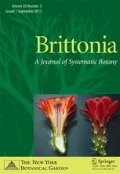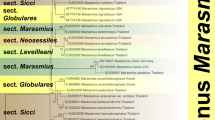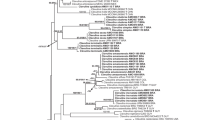Abstract:
Leucoagaricus taniae (Agaricaceae) is described as new to science. It was found growing in sand at Armação beach on Santa Catarina Island in Southern Brazil covered by sand among Canavalia rosea (Fabaceae) and Cyperus pedunculatus (Cyperaceae). The new species has a cream white pileus that is up to 50 mm in diameter and exudes golden drops when fresh. The stipe is up to 60 mm height, with rhizomorphs at the end of the volvate base. Photographs of fresh basidiomes in situ and illustrations of the main micromorphological features are presented. A molecular-phylogenetic analysis that includes the species is also presented.



Similar content being viewed by others
Literature cited
Araujo, D. S. D., F. R. Scarano, C. F. C. Sá, B. C. Kurtz, H. L. T. Zaluar, R. C. M. Montezuma & R. C. Oliveira. 1998. Comunidades vegetais do Parque Nacional da Restinga de Jurubatiba. Pp. 39–62in: Esteves, F. A. (ed.), Ecologia das lagoas costeiras do Parque Nacional da Restinga de Jurubatiba e do Município de Macaé (RJ). Departamento de Ecologia, Instituto de Biologia, Universidade Federal do Rio de Janeiro, Rio de Janeiro.
Albuquerque, M. P., A. B. Pereira & A. A. de Carvalho Jr. 2007. Novas ocorrências de Agaricales para o Brasil. Revista Brasileira de Biociências 5(S2): 1143–1145.
Barcelos, M. E., J. R. Riguete, L. T. Silva & P. F. Ferreira Jr. 2012. Uma visão panorâmica sobre os solos das restingas e seu papel na definição de comunidades vegetais nas planícies costeiras do sudeste do Brasil. Natureza online 10(2): 71–76.
Batista, A. C. 1957. Alguns Agaricaceae saprofitos de Pernambuco. Mycopathologia et Mycologia Applicata 8: 127–134. https://doi.org/10.1007/BF02130068
Bon, M. 1993. Flore mycologique d’Europe 3: Les Lepiotes. CRDP de Picardie, Amiens Cedex.
Bon, M. & J. Boiffard. 1974. Lépiotes de Vendée et de la Côte atlantique française (1). Bulletin Trimestriel de la Societe Mycologique de France 90: 287–306.
Brazil Flora Group. 2021. Brazilian Flora 2020 project - Projeto Flora do Brasil 2020. v393.274. Instituto de Pesquisas Jardim Botânico do Rio de Janeiro. Dataset/Checklist. https://doi.org/10.15468/1mtkaw
Chapela, I. H, S. A. Rehner, T. R. Schultz & U. G. Mueller. 1994. Evolutionary history of the symbiosis between fungus-growing ants and their fungi. Science 266(5191): 1691–1694. https://doi.org/10.1126/science.266.5191.1691
Clark, P. U., J. A. Church, J. M. Gregory & A. J. Payne. 2015. Recent progress in understanding and projecting regional and global mean sea level change. Current Climate Change Reports 1: 224–246. https://doi.org/10.1007/s40641-015-0024-4
Consiglio, G. & M. Contu. 2004. Some rare, interesting species of Leucoagaricus subgen. Sericeomyces. Micologia e Vegetazione Mediterranea 19(1): 57–72.
Dahlberg, A. & G. M. Mueller. 2011. Applying IUCN red-listing criteria for assessing and reporting on the conservation status of fungal species. Fungal Ecology 4(2): 147–162. https://doi.org/10.1016/j.funeco.2010.11.001
Darriba, D., G. L. Taboada, R. Doallo & D. Posada. 2012. jModelTest 2: more models, new heuristics and parallel computing. Nature Methods 9(8): 772–772. https://doi.org/10.1038/nmeth.2109
De Meijer, A. A. R. 2006. Preliminary list of the macromycetes from the Brazilian state of Paraná. Boletim do Museu Botânico Municipal. Prefeitura Municipal de Curitiba. Secretaria Municipal do Meio Ambiente. Departamento de Produção Vegetal 68: 1–53.
Dentinger, B. T. M., S. Margaritescu & J. M. Moncalvo. 2010. Rapid and reliable high-throughput methods of DNA extraction for use in barcoding and molecular systematics of mushrooms. Molecular Ecology Resources 10: 628–633. https://doi.org/10.1111/j.1755-0998.2009.02825.x
Dutta, A. K., J. K. Stallman, S. Bera, E. Hoque, S. Paloi & K. Acharya. 2021. Lepiotaceous fungi of West Bengal, India: two new species of Leucoagaricus. Mycological Progress 20: 493–507. https://doi.org/10.1007/s11557-021-01685-w
Ferreira, A. J. & V. G. Cortez. 2012. Lepiotoid Agaricaceae (Basidiomycota) from São Camilo State Park, Paraná State, Brazil. Mycosphere 3(6): 962–976.
Forzza, R. C., J. F. A. Baumgratz, C. E. M. Bicudo, D. A. L. Canhos, A. A. de Carvalho Jr., M. A. N. Coelho, A. F. Costa, D. P. Costa, M. G. Hopkins, P. M. Leitman, L. G. Lohmann, E. N. Lughadha, L. C. Maia, G. Martinelli, M. Menezes, M. P. Morim, A. L. Peixoto, J. R. Pirani, J. Prado, L. P. Queiroz, S. Souza, V. C. S. Souza, J. R. Stehmann, L. S. Sylvestre, B. M. T. Walter & D. C. Zappi. 2012. New Brazilian floristic list highlights conservation challenges. BioScience 62(1): 39–45. https://doi.org/10.1525/bio.2012.62.1.8
Forzza, R. C., J. F. A. Baumgratz, C. E. M. Bicudo, D. A. L. Canhos, A. A. de Carvalho Jr., A. F. Costa, D. P. Costa, M. Hopkins, P. M. Leitman, L. G. Lohmann, L. C. Maia, G. Martinelli, M. Menezes, M. P. Morim, M. A. Nadruz-Coelho, A. L. Peixoto, J. R. Pirani, J. Prado, L. P. Queiroz, V. C. Souza, J. R. Stehmann, L. Sylvestre, B. M. T. Walter & D. Zappi. (eds.). 2010. Catálogo de plantas e fungos do Brasil. 2 vols. Andrea Jakobsson Estúdio / Jardim Botânico do Rio de Janeiro, Rio de Janeiro.
Gennari, A., V. Migliozzi & J. L. Siquier Virgòs. 1995. Tre interessanti Leucocoprinee sabulicole. Leucoagaricus gaillardii Bon & Boiffard, Sericomyces subvolvatus (Malençon & Bertault) Contu fo. subvolvatus e S. subvolvatus fo. pictus (Malençon & Bertault) Bon. Micologia e Vegetazione Mediterranea 10(1): 9–21.
Grandi, R. A. P., G. Guzmán & V. L. R. Bononi. 1984. Adições às Agaricales (Basidiomycetes) do Parque Estadual das Fontes do Ipiranga, São Paulo, SP, Brasil. Rickia 11: 27–33.
He, M. Q., R. L. Zhao, K. D. Hyde, D. Begerow, M. Kemler, A. Yurkov, E. H. C. McKenzie, O. Raspe, M. Kakishima, S. Sánchez-Ramírez, E. C. Vellinga, R. Halling, V. Papp, I. V. Zmitrovich, B. Buyck, D. Ertz, N. N. Wijayawardene, B. K. Cui, N. Schoutteten, X. Z. Liu, T. H. Li, Y. J. Yao, X. Y. Zhu, A. Q. Liu, G. J. Li, M. Z. Zhang, Z. L. Ling, B. Cao, V. Antonín, T. Boekhout, B. D. B. Silva, E. De Crop, C. Decock, B. Dima, A. K. Dutta, J. W. Fell, J. Geml, M. Ghobad-Nejhad, A. J. Giachini, T. B. Gibertoni, S. P. Gorjón, D. Haelewaters, S. H. He, B. P. Hodkinson, E. Horak, T. Hoshino, A. Justo, Y. W. Lim, N. Menolli Jr., A. Mešić, J. M. Moncalvo, G. M. Mueller, L. G. Nagy, R. H. Nilsson, M. Noordeloos, J. Nuytinck, T. Orihara, C. Ratchadawan, M. Rajchenberg, A. G. S. Silva-Filho, M. A. Sulzbacher, Z. Tkalčec, R. Valenzuela, A. Verbeken, A. Vizzini, F. Wartchow, M. Weiß, C. L. Zhao & P. M. Kirk. 2019. Notes, outline and divergence times of Basidiomycota. Fungal Diversity 99(1): 105–367. https://doi.org/10.1007/s13225-019-00435-4
Heisecke, C., J. A. D. Barbosa, M. A. Neves & A. A. de Carvalho Jr. 2021. Taxonomic and nomenclatural novelties in Leucoagaricus (Agaricaceae) from Brazil. Phytotaxa 494(1): 42–58. https://doi.org/10.11646/phytotaxa.494.1.2
IUCN. 2012. IUCN Red List Categories and Criteria. Version 3.1, Second edition. IUCN, Gland, Switzerland and Cambridge, UK.
IUCN Standards and Petitions Committee. 2019. Guidelines for using the IUCN Red List Categories and Criteria. Version 14. http://www.iucnredlist.org/documents/RedListGuidelines.pdf.
Ješovnik, A., J. Sosa-Calvo, M. W. Lloyd, M. G. Branstetter, F. Fernandez & T. R. Schultz. 2017. Phylogenomic species delimitation and host-symbiont coevolution in the fungus-farming ant genus Sericomyrmex Mayr (Hymenoptera: Formicidae): ultraconserved elements (UCEs) resolve a recent radiation. Systematic Entomology 42(3): 523–542. https://doi.org/10.1111/syen.12228
Johnson, J. 1999. Phylogenetic relationships within Lepiota sensu lato based on morphological and molecular data. Mycologia 91(3): 443–458. https://doi.org/10.2307/3761345
Johnson, J. & R. Vilgalys. 1998. Phylogenetic systematics of Lepiota sensu lato based on nuclear large subunit rDNA evidence. Mycologia 90(6): 971–979. https://doi.org/10.2307/3761269
Justo, A., C. Angelini & A. Bizzi. 2021. The genera Leucoagaricus and Leucocoprinus in the Dominican Republic. Mycologia 113(2): 348–389. https://doi.org/10.1080/00275514.2020.1819142
Justo, A., C. Angelini, A. Bizzi & A. Vizzini. 2015. Leucoagaricus sabinae (Agaricaceae), a new species from the Dominican Republic. North American Fungi 10: 1–15. https://doi.org/10.2509/naf2015.010.005
Katoh, K. & D. M. Standley. 2013. MAFFT multiple sequence alignment software version 7: improvements in performance and usability. Molecular Biology and Evolution 30(4): 772–780. https://doi.org/10.1093/molbev/mst010
Kearse, M., R. Moir, A. Wilson, S. Stones-Havas, M. Cheung, S. Sturrock, S. Buxton, A. Cooper, S. Markowitz, C. Duran, T. Thierer, B. Ashton, P. Mentjies & A. Drummond. 2012. Geneious Basic: an integrated and extendable desktop software platform for the organization and analysis of sequence data. Bioinformatics 28(12): 1647–1649. https://doi.org/10.1093/bioinformatics/bts199
Kornerup, A. & J. H. Wanscher. 1978. Methuen Handbook of Colour. 3rd Edition. Eyre Methuen, London.
Kumar, T. A. & P. Manimohan. 2004. A new species of Leucocoprinus from India. Mycotaxon 90(2): 393–397.
Largent, D. L. 1986. How to Identify Mushrooms to Genus I: Macroscopic Features. 3rd Edition. Mad River Press Inc., Eureka.
Largent, D. L., D. Johnson & R. Watling. 1977. How to Identify Mushrooms to Genus III: Microscopic Features. 3 ed. Mad River Press Inc., Eureka.
Leão, Z. M. A. N. & J. M. L. Dominguez. 2000. Tropical coast of Brazil. Marine Pollution Bulletin 41: 112–122.
Lodge, D. J., J. F. Ammirati, T. E. O’Dell & G. M. Mueller. 2004. Collecting and describing macrofungi. Pp. 128–158in: G. M. Mueller, G. F. Bills & M. S. Foster, Biodiversity of Fungi. Inventory and Monitoring Methods. Elsevier Academic Press.
Magnago, A. C., J. J. S. Oliveira, A. N. M. Furtado, S. Urrea-Valencia & M. A. Neves. 2013. Basidiomycota. Mushrooms. Pp. 23–50in: M. A. Neves, I. G. Beseia, E. R. Drechsler-Santos & A. Góes-Neto, Guide to the Common Fungi of the Semiarid Region of Brazil, TECC.
Magnago, L. F. S., S. V. Martins, C. E. G. R. Schaefer & A. V. Neri. 2010. Gradiente fitofisionômico-edáfico em formações florestais de restinga no sudeste do Brasil. Acta Botânica Brasílica 24: 734–746.
Maia, L. C. & A. A. de Carvalho Jr. 2010. Fungos do Brasil. Pp. 43–48in: R. C. Forzza et al. (orgs.), Catálogo de Plantas e Fungos do Brasil. Vol.1. Andrea Jakobsson Estúdio /Instituto de Pesquisas Jardim Botânico do Rio de Janeiro, Rio de Janeiro.
Maia, L. C., A. M. Yano-Melo & M. A. Q. Cavalcanti. 2002. Diversidade de Fungos no Estado de Pernambuco. Pp. 15–50in: M. Tabarelli & J. M. C. Silva (eds.), Diagnóstico da Biodiversidade de Pernambuco. Ed. Massangana, Recife.
Maia, L. C., A. A. de Carvalho Jr., L. H. Cavalcanti, A. M. Gugliotta, E. R. Drechsler-Santos, A. L. M. A. Santiago, M. E. S. Cáceres, T. B. Gibertoni, A. Aptroot, A. J. Giachini, A. M. S. Soares, A. C. G. Silva, A. C. Magnago, B. T. Goto, C. R. S. Lira, C. A. S. Montoya, C. L. A. Pires-Zottarelli, D. K. A. da Silva, D. J. Soares, D. H. C. Rezende, E. D. M. N. Luz, E. L. Gumboski, F. Wartchow, F. Karstedt, F. M. Freire, F. P. Coutinho, G. S. N. de Melo, H. M. P. Sotão, I. G. Baseia, J. Pereira, J. J. S. de Oliveira, J. F. Souza, J. L. Bezerra, L. H. Cavalcanti, L. S. Araujo Neta, L. H. Pfenning, L. F. P. Gusmão, M. A. Neves, M. Capelari, M. C. W. Jaeger, M. P. Pulgarín, N. Menolli Jr., P. S. Medeiros, R. C. S. Friedrich, R. S. Chikowski, R. M. Pires, R. F. Melo, R. M. B. da Silveira, S. Urrea-Valencia, V. G. Cortez & V. F. da Silva. 2015. Diversity of Brazilian Fungi. Rodriguésia 66(4): 1033–1045. https://doi.org/10.1590/2175-7860201566407
Menolli Jr., N. & M. Sánchez-García. 2019. Brazilian fungal diversity represented by DNA markers generated over 20 years. Brazilian Journal of Microbiology 51: 729–749. https://doi.org/10.1007/s42770-019-00206-y
Miller, M. A., W. Pfeiffer & T. Schwartz. 2010. Creating the CIPRES Science Gateway for inference of large phylogenetic trees. In: Proceedings of the Gateway Computing Environments Workshop (GCE). San Diego Supercomputer.Center, New Orleans, Louisiana.
Miller, O. K., D. J. Lodge & T. J. Baroni. 2000. New and interesting ectomycorrhizal fungi from Puerto Rico, Mona, and Guana Islands. Mycologia 92: 558–570. https://doi.org/10.1080/00275514.2000.12061193
Möller, A. 1893. Die Pilzgärten einiger südamerikanischer Ameisen (No. 6). Botanische Mitteilungen aus den Tropen 6: 1–127.
Muchovej, J. J, T. M. Della Lucia & R. M. C. Muchovej. 1991. Leucoagaricus weberi sp. nov. from a live nest of leaf-cutting ants. Mycological Research 95(11): 1308–1311.
Mueller, U. G., S. A. Rehner & T. R. Schultz. 1998. The evolution of agriculture in ants. Science 281(5385): 2034–2038. https://doi.org/10.1126/science.281.5385.2034
Mueller, U. G., T. R. Schultz, C. R. Currie, R. M. Adams & D. Malloch. 2001. The origin of the attine ant-fungus mutualism. The Quarterly Review of Biology 76(2): 169–197. https://doi.org/10.1086/393867
Munoz, G., A. Caballero, J. C. Salom, E. Ercole & A. Vizzini. 2015. Leucoagaricus viridariorum (Agaricaceae, Agaricales), a new species from Spain. Phytotaxa 236(3): 226–236
Orton, P. D. 1960 New check list of British Agarics and Boleti: part III. Notes on genera and species in the list. Transactions of the British Mycological Society 43(2): 159–384.
Pagnocca, F. C., M. Bacci Jr., M. H. Fungaro, O. C. Bueno, M. J. Hebling, A. Sant'anna & M. Capelari. 2001. RAPD analysis of the sexual state and sterile mycelium of the fungus cultivated by the leaf-cutting ant Acromyrmex hispidus fallax. Mycological Research 105: 173–176. https://doi.org/10.1017/S0953756200003191
Pegler, D. N. 1997 The Agarics of Sao Paulo: An Account of the Agaricoid Fungi (Holobasidiomycetes) of Sao Paulo State, Brazil. Royal Botanic Gardens, Kew.
Rambaut, A., M. A. Suchard, D. Xie & A. J. Drummond. 2014. Tracer v.1.6. Available at: http://beast.bio.ed.ac.uk/Tracer [accessed 12 Aug. 2020].
Rick, J. 1937. Agarici Riograndenses. Lilloa 1: 307–346.
Rick, J. 1961. Basidiomycetes eubasidii in Rio Grande do Sul – Brasilia. 5. Agaricaceae. Iheringia. Série Botânica 8: 296–450.
Rick, J. 1920. Contributio ad monographiam Agaricearum brasiliensium. Brotéria Série Botânica 18: 48–63
Ronquist, F., M. Teslenko, P. van der Mark, D. Ayres, A. Darling, S. Höhna, B. Larget, L. Liu, M. A. Suchard & J. P. Huelsenbeck. 2011. MrBayes 3.2: Efficient Bayesian phylogenetic inference and model choice across a large model space. Systematic Biology 61(3): 539–542. https://doi.org/10.1093/sysbio/sys029
Rosa, L. H. & M. Capelari. 2009. Agaricales fungi from Atlantic Rain Forest fragments in Minas Gerais, Brazil. Brazilian Journal of Microbiology 40: 846–851. https://doi.org/10.1590/S1517-83822009000400015
Rother, M. S. & R. M. B. Silveira. 2008. Família Agaricaceae (Agaricales, Basidiomycota) no Parque Estadual de Itapuã, Viamão, Rio Grande do Sul, Brasil. Revista Brasileira de Biociências: Brazilian Journal of Biosciences 6(3): 259–268.
Rother, M. S. & R. M. B. Silveira. 2009. Leucoagaricus lilaceus (Agaricaceae), a poorly known Neotropical agaric. Mycotaxon 107: 473–481.
Saccardo, P. A. 1891. Supplementum Universale, Pars. I. Sylloge Fungorum 9: 1–1141. https://doi.org/10.5962/bhl.title.5371
Scarano, F. R. 2002. Strucuture, function and floristic relationships of plant communities in stressful habitats marginal to the Brazilian Atlantic Rainforest. Annals of Botany 90(4): 517–524.
Silva-Pinhati, A. C. O., M. Bacci Jr, G. Hinkle, M. L. Sogin, F. C. Pagnocca, V. G. Martins, O. C. Bueno & M. J. A. Hebling. 2004. Low variation in ribosomal DNA and internal transcribed spacers of the symbiotic fungi of leaf-cutting ants (Attini: Formicidae). Brazilian Journal of Medical and Biological Research 37(10): 1463–1472. https://doi.org/10.1590/S0100-879X2004001000004
Singer, R. 1948. Diagnoses fungorum novorum Agaricalium. Sydowia 2(1–6): 26–42.
Singer, R. 1949[1951]. The Agaricales (Mushrooms) in modern taxonomy. Lilloa 22: 1–832.
Singer, R. 1953. Type studies on Basidiomycetes. VI. Lilloa 26: 57–159.
Singer, R. 1966[1968]. Sand-dune inhabiting fungi of the South Atlantic coast from Uruguay to Bahía Blanca. Mycopathologia et Mycologia Applicata 34: 129–143. https://doi.org/10.1007/BF02051422
Singer, R. 1986. The Agaricales in Modern Taxonomy, 4th ed. Koeltz Scientific Books, Königstein.
Singer, R. 1989. New taxa and new combinations of Agaricales (Diagnoses fungorum novorum Agaricalium 4). Fieldiana Botany 21: 1–133.
Sobestiansky, G. 2005. Contribution to a macromycete survey of the States of Rio Grande do Sul and Santa Catarina in Brazil. Brazilian Archives of Biology and Technology 48(3): 437–457. https://doi.org/10.1590/S1516-89132005000300015
Spegazzini, C. 1889. Fungi puiggariani. Pugillus I. Boletin de la Academia Nacional de Ciencias en Córdoba, República Argentina 11: 381–622. https://doi.org/10.5962/bhl.title.3624
Spielmann, A. A. & J. Putzke. 1998. Leucoagaricus gongylophorus (Agaricales, Basidiomycota) em ninho ativo de formigas Attini (Acromyrmex Aspersus). Caderno de Pesquisa, ser. Botânica 10(1/2):27–36.
Stamatakis, A. 2014. RAxML version 8: a tool for phylogenetic analysis and post-analysis of large phylogenies. Bioinformatics 30(9): 1312–1313. https://doi.org/10.1093/bioinformatics/btu033
Vellinga, E. C. 1988. Glossary. Pp. 54–64 in: M. E. Noordeloos, T. W. Kuyper, E. C. Vellinga, Flora Agaricina Neerlandica, vol. 2. AA Balkema Publishers, Lisse.
Vellinga, E. C. 2000. Notes on Lepiota and Leucoagaricus. Type studies on Lepiota magnispora, Lepiota barssii, and Agaricus americanus. Mycotaxon 76: 429–438.
Vellinga, E. C. 2001. Leucoagaricus Locq. ex Singer. Pp. 85–108in: M. E. Noordeloos, T. W. Kuyper & E. C. Vellinga, Flora Agaricina Neerlandica, vol. 5: AA Balkema Publishers, Lisse.
Vellinga, E. C. 2004a. Ecology and distribution of Lepiotaceous fungi (Agaricaceae) – A Review. Nova Hedwigia 78(3): 273–299. https://doi.org/10.1127/0029-5035/2004/0078-0273
Vellinga, E. C. 2004b. Genera in the family Agaricaceae: evidence from nrITS and nrLSU sequences. Mycological Research 108(4): 354–377. https://doi.org/10.3852/10-204
Vellinga, E. C. 2010. Nomenclatural overview of Lepiotaceous Fungi. Version 4.8.
Vellinga, E. C. & R. B. Balsley. 2010. Leucoagaricus dacrytus–a new species from New Jersey, USA. Mycotaxon 113(1): 73–80. https://doi.org/10.5248/113.73
Vellinga, E. C. & R. M. Davis. 2006. Lepiotaceous fungi from California, USA 1-Leucoagaricus amanitoides sp. nov. Mycotaxon 98:197–204.
Vellinga, E. C. & M. E. Noordeloos. 2001. Glossary. Pp. 6–11in: M. E. Noordeloos, T. W. Kuyper, E. C. Vellinga, Flora Agaricina Neerlandica, vol. 5. AA Balkema Publishers, Lisse.
Vellinga, E. C., P. Sysouphanthong & K. D. Hyde. 2011. The family Agaricaceae: phylogenies and two new white-spored genera. Mycologia 103(3): 494–509. https://doi.org/10.3852/10-204
Wartchow, F., J. Putzke & M. A. D. Q. Cavalcanti. 2008. Agaricaceae Fr. (Agaricales, Basidiomycota) from areas of Atlantic Forest in Pernambuco, Brazil. Acta Botânica Brasílica 22(1): 287–299. https://doi.org/10.1590/S0102-33062008000100026
Yuan, Y., Y. K. Li & J. F. Liang. 2014. Leucoagaricus tangerinus, a new species with drops from southern China. Mycological Progress 13: 893–898. https://doi.org/10.1007/s11557-014-0974-2
Zeller, S. M. 1934. A new species of Lepiota. Mycologia 26(3): 210–211. https://doi.org/10.1080/00275514.1934.12020716
Acknowledgements
This study was financed in part by the Coordenação de Aperfeiçoamento de Pessoal de Nível Superior–Brasil (CAPES) – Finance Code 001. The authors thank Ariadne Furtado for help with sequencing, the Synchronicity Earth (https://www.synchronicityearth.org) for choosing this mushroom for financial support, and the editor and two anonymous reviewers for improving the manuscript.
Author information
Authors and Affiliations
Corresponding author
Ethics declarations
The authors declare that they have no known competing financial interests or personal relationships that could have appeared to influence the work reported in this paper.
Supplementary Information
ESM 1
(TXT 62 kb)
Rights and permissions
About this article
Cite this article
Heisecke, C., Lima, D.F., Mueller, G.M. et al. Leucoagaricus taniae sp. nov. (Agaricaceae), a sand-dwelling mushroom from Brazil. Brittonia 74, 18–29 (2022). https://doi.org/10.1007/s12228-021-09693-6
Received:
Revised:
Accepted:
Published:
Issue Date:
DOI: https://doi.org/10.1007/s12228-021-09693-6




